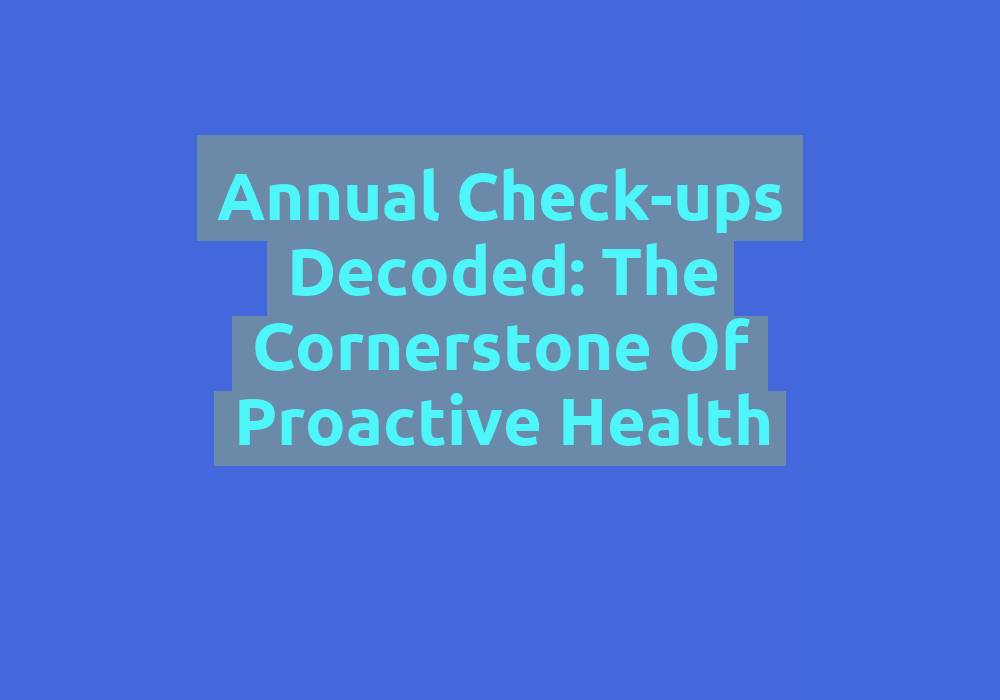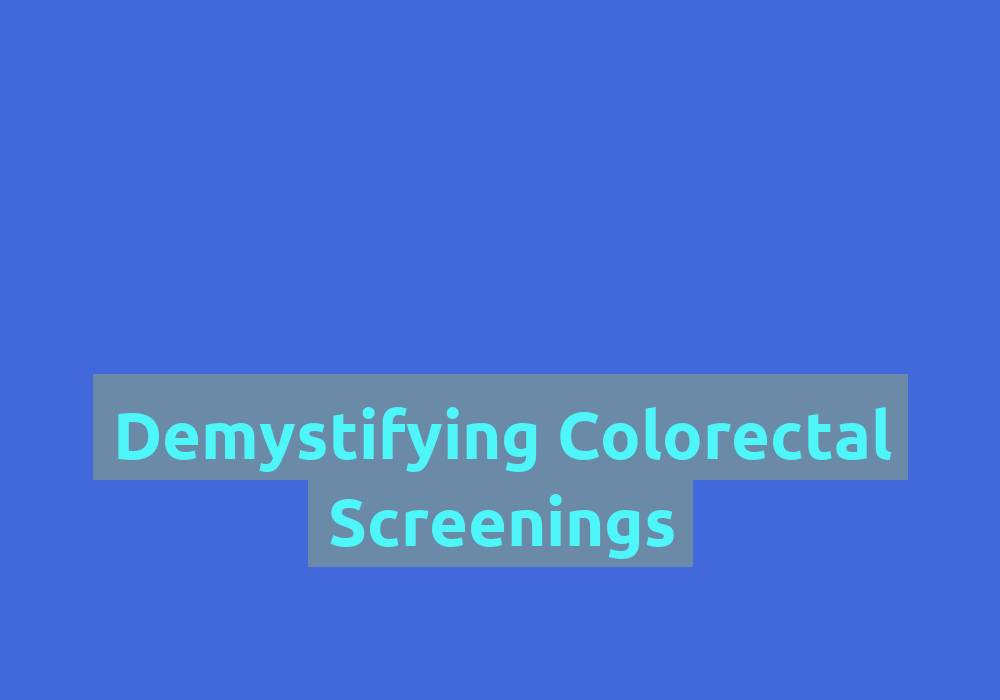Annual Check-ups Decoded: The Cornerstone of Proactive Health

Annual check-ups play a crucial role in maintaining optimal health and well-being. These comprehensive screenings are a cornerstone of proactive healthcare and are essential for detecting potential health issues before they become serious. In this article, we will delve into the importance of annual check-ups, understand the various components involved, and explore the benefits they offer in promoting overall wellness.
The Importance of Annual Check-ups
Regular check-ups enable individuals to take control of their health by providing an opportunity to identify and address any underlying health concerns. These scheduled visits to healthcare professionals serve as a preventive measure, emphasizing early detection and timely intervention. By proactively monitoring our health, we can significantly reduce the risk of developing chronic conditions and improve the effectiveness of treatments.
During an annual check-up, your healthcare provider will review your medical history, including previous illnesses, surgeries, and medications. This review helps in understanding your overall health and identifying any specific risk factors or concerns. It allows healthcare professionals to gain insights into your medical background, which can be vital in determining appropriate preventive measures and treatment plans. By comprehensively reviewing your medical history, the healthcare provider can better tailor their recommendations for a healthier future.
A thorough physical examination is an essential part of an annual check-up. Your healthcare provider will evaluate your vital signs, such as blood pressure, heart rate, and body mass index (BMI). They may also examine specific body systems, such as the respiratory, cardiovascular, and musculoskeletal systems. Additionally, they may conduct a clinical breast examination, pelvic examination, or prostate examination, depending on your age and gender. These physical examinations help detect any abnormalities or potential signs of underlying health issues that may require further investigation or intervention.
Comprehensive annual check-ups often involve various laboratory tests to assess your overall health status. These tests may include blood tests to evaluate cholesterol levels, blood sugar levels, kidney function, liver function, and thyroid function. Additionally, a urine sample may be collected for analysis, providing insights into kidney function and potential infections. These laboratory tests provide objective data about your health, allowing healthcare professionals to identify any potential red flags or abnormalities that may require further evaluation or treatment.
Cancer screenings are an integral part of annual check-ups, aiming to detect early signs of cancers when they are most treatable. These screenings may include mammograms for breast cancer, Pap smears for cervical cancer, colonoscopies for colorectal cancer, and prostate-specific antigen (PSA) tests for prostate cancer. The specific screenings recommended may vary based on factors such as age, gender, family history, and personal risk factors. Early detection of cancer significantly improves the chances of successful treatment and better long-term outcomes.
Annual check-ups present an opportunity to ensure that individuals are up-to-date with their immunizations and vaccinations. These preventive measures help protect against a range of diseases, including influenza, pneumonia, tetanus, and hepatitis. Your healthcare provider will review your immunization history and administer any necessary vaccines based on current guidelines. By staying up-to-date with immunizations, you can reduce the risk of contracting preventable diseases and their potential complications.
In addition to the physical examinations and tests, annual check-ups also involve discussions about lifestyle choices and behaviors that may impact your health. These conversations may cover topics such as diet, exercise, smoking cessation, alcohol consumption, stress management, and mental well-being. By addressing these aspects, healthcare professionals can provide personalized recommendations to promote healthier habits and reduce the risk of chronic diseases. They can offer guidance on adopting a balanced diet, engaging in regular physical activity, managing stress effectively, and seeking support for mental well-being. These discussions empower individuals to make informed choices and take steps towards a healthier lifestyle.
The Benefits of Annual Check-ups
Annual check-ups offer numerous benefits that contribute to overall well-being. Some of the key advantages include:
-
Early Detection of Health Issues: Regular check-ups increase the chances of detecting potential health problems at an early stage. This allows for timely intervention and treatment, minimizing the risk of complications and improving outcomes. Detecting conditions such as high blood pressure, high cholesterol, diabetes, or cancer in their early stages can significantly improve long-term prognosis and quality of life.
-
Prevention and Risk Reduction: Annual check-ups focus on preventive care, empowering individuals to adopt healthier habits and lower their risk of developing chronic diseases. By discussing lifestyle choices and behaviors, healthcare providers can offer guidance on proper nutrition, physical activity, stress management, and other strategies to reduce the risk factors associated with various health conditions. This proactive approach helps individuals make positive changes and prevent the onset of diseases.
-
Personalized Healthcare Guidance: During annual check-ups, healthcare professionals provide personalized guidance based on individual health needs and risks. They can address specific concerns, offer recommendations for disease prevention, and tailor advice to suit each patient’s unique circumstances. This personalized approach enhances patient engagement and empowers individuals to actively participate in their own healthcare journey. By understanding individual needs, healthcare providers can develop customized strategies to optimize health outcomes.
-
Continuity of Care: Regular check-ups establish a strong foundation for long-term healthcare. By consistently monitoring your health status, healthcare providers can develop a comprehensive understanding of your medical history and make informed decisions regarding your care. This continuity of care ensures optimal management of chronic conditions, timely adjustments to treatment plans, and effective coordination with specialists when necessary. It also facilitates early detection of any changes or developments in your health, allowing for prompt intervention.
In conclusion, annual check-ups serve as the cornerstone of proactive health by enabling early detection, prevention, and personalized healthcare guidance. These comprehensive assessments encompass various screenings, examinations, and discussions that collectively contribute to maintaining optimal well-being. By prioritizing regular check-ups, individuals can take charge of their health and work towards a healthier and more fulfilling life. So, schedule your annual check-up today and invest in your long-term well-being.
-
Why are annual check-ups important?
Annual check-ups are important because they allow for early detection of health issues, promote prevention and risk reduction, provide personalized healthcare guidance, and ensure continuity of care. -
What does a comprehensive annual check-up involve?
A comprehensive annual check-up involves reviewing medical history, conducting a thorough physical examination, performing various laboratory tests, and recommending cancer screenings. It also includes discussions about lifestyle choices and behaviors. -
What are the benefits of annual check-ups?
The benefits of annual check-ups include early detection of health issues, prevention and risk reduction, personalized healthcare guidance, and continuity of care. -
How do annual check-ups contribute to overall well-being?
Annual check-ups contribute to overall well-being by enabling early detection and treatment of health problems, empowering individuals to adopt healthier habits, providing personalized guidance, and establishing a strong foundation for long-term healthcare.

